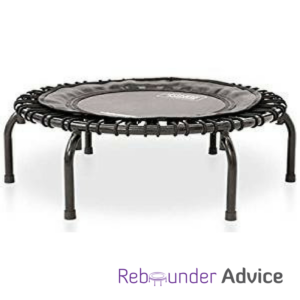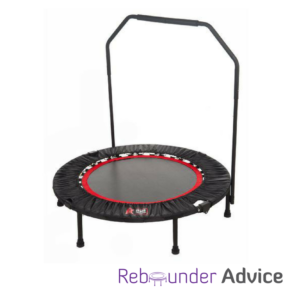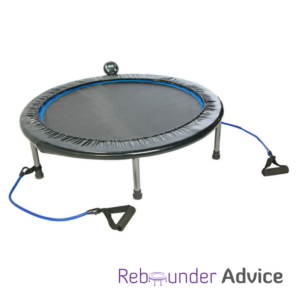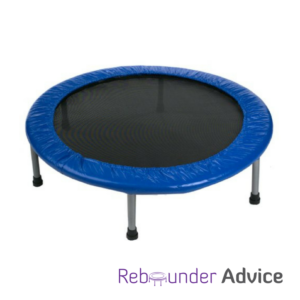
Rebounder Advice is your one-stop hub to find all the information you need in the bouncy world of Rebounders and Mini Trampolines.
Come on the journey as we explore the many benefits of rebounding, along with how to use them safely and effectively from the comfort of your own home.
Ready to purchase your own rebounder? Use our reviews to find the best mini trampoline that suits you!
Best Rebounder Brands
| Brand | Model | User Rating | Check Price | Read Full Review | Price Range |
| Jump Sport | JumpSport Fitness Trampoline Model 220 |  | JumpSport Review | $$ | |
| Urban Rebounder | Elevated Urban Rebounder |  | Urban Rebounder Review | $$ | |
| Bellicon | Bellicon Classic Mini Trampoline | Bellicon Classic Mini Trampoline Review | $$$ | ||
| Stamina | Stamina InTone Plus |  | Stamina InTone Plus Review | $ | |
| Variflex | AirZone MiniBand Fitness Trampoline |  | AirZone MiniBand Fitness Review | $ |
What is a Rebounder?
For those of us who are old enough to know, mini trampolines were very popular for exercise in the 1980’s (don’t worry – no fluoro leg warmers required!). NASA even did a study on them, showing many great advantages for their use. Unfortunately the excitement faded pretty quickly though, and people lost interest in their use. Also, the cheap imports of low-quality rebounders flooded the market and left fellow users unsatisfied. Rebounders soon made their way deep into the back of people’s cupboards, collecting dust and never to be heard of again.
… Until now…recently in the last few years rebounders are slowly making a come-back and are once again gaining our attention. And for good reason too! They are a perfect way to exercise with low impact to your joints and feet. They absorb almost 85% of the shock and jarring that your body experiences due to the springs and elastic mat. Not only that but they’re fun to use too! As people embark on the never-ending journey to lose weight and improve their fitness, rebounders are fast becoming a popular “go-to” piece of exercise equipment.
What Can I use a Rebounder for?
Rebounders can also be known as “mini trampoline”. However, they do differ from your traditional trampoline. Rebounders are much smaller in size (typically 3 to 4 feet in diameter), and are primarily used indoors for individual exercise and rehabilitation.
You can use a mini trampoline simply by starting with some light bouncing or rocking. This alone can help with improved lymphatic system and circulation. You can then progress to small bounces or even walking on the spot, which will help get the blood pumping and heart rate to rise. For a more intense rebounder workout you can then progress to higher-interval exercises such as jogging, jumping jacks, and even dancing or strength training.
Check out some of our rebounding exercises here for more ideas on how you can use your rebounder.
You will find that most manufacturers will also provide rebounder accessories to assist with your use. Common accessories can be a stabilising bar (great to assist with your balance or for any balancing exercises), small hand weights or resistance bands (great for strength and conditioning), and often a carry bag (perfect for easy storage and portability). Most people use rebounders in their own home. But as they are becoming more popular for their many benefits they are now often found in Rehabilitation Centers and Health Clubs.
How to Choose a Rebounder?
If you have decided to invest in your very own rebounder, that’s great! But how do you choose which one is suitable for what you need? Consider these following factors before..*ahem* jumping into your new purchase:
Look for a mat that is made with good quality elastic, which is strong and durable. The more you intend to use your rebounder, the more you want to pay attention to a good quality mat.
There are a few elements of the frame to consider. The most important point you want to look for is a frame that is nice and strong. Next, most legs are foldable, which isn’t a necessity but does make for easy storage. Similarly, most frames are now foldable (either in half or quarters), allowing rebounders to be far more portable. But regardless, if using your rebounder excessively the key element to look for is that strong, sturdy frame.
Typically most rebounders use springs, and that’s ok. But make sure the springs are durable and can last the extra mile. Higher end brands have now replaced springs with bungee cords. This comes with a higher price tag, but makes for a much smoother bounce and far less jarring on your joints (and they’re quieter – bonus!).
This is not crucial, but choosing a brand or model which also provides replacements and alternative accessories is certainly handy if ever needed. There’s nothing worse than needing to replace springs or mat and it isn’t an option! Rather than replacing the whole rebounder unit, replacing just the springs or mat can help to save costs. Similarly consider accessories only if needed – for example, a stabilising bar is handy to have if you are a little unsure on your feet, or intend to do a lot of balancing exercises.
At the end of the day, everyone’s goals and budget is different when it comes to purchasing a mini trampoline. The two most important factors for you is to consider is to what intensity you will be using your rebounder, and how much you can spend. If you are using your rebounder for light activities and irregular use, then perhaps start with a lower model and see how you like it before purchasing a more expensive model. However, if you intend to use your rebounder for higher intensity exercises (and a lot more often), you would be better off investing a little more for a better model….hey – overall it may still be cheaper than a gym membership!
There’s lots of Rebounders out there now – make sure you find the one that’s right for you.
